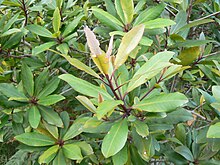| Cape beech | |
|---|---|

| |

| |
| Scientific classification | |
| Kingdom: | Plantae |
| Clade: | Tracheophytes |
| Clade: | Angiosperms |
| Clade: | Eudicots |
| Clade: | Asterids |
| Order: | Ericales |
| Family: | Primulaceae |
| Genus: | Myrsine |
| Species: | M. melanophloeos |
| Binomial name | |
| Myrsine melanophloeos (L.) R.Br. ex Sweet (1818) | |
| Synonyms | |
Synonymy
| |
Myrsine melanophloeos, commonly known as Cape beech, Kaapse boekenhout (Afrikaans), isiCalabi (Zulu) or isiQwane sehlati (Xhosa) is a dense evergreen tree that is native to the afromontane forests of Africa, ranging from Nigeria and Sudan to South Africa. Outside forests they are also commonly encountered along stream banks and in gullies.
Despite its common name, it is not a close relative of the familiar beech tree of the northern hemisphere, and it is actually more closely related to the Rhododendrons; it comes from the beech-like grain of its wood. The Xhosa name isiQwane sehlati meaning "forest protea" comes from the tree's leaves bunching like a protea (isiQwane) flower.
Distribution

The natural range of this stately tree is from Cape Town in the south, to Ethiopia and Nigeria in the north. In the Eastern Cape it is sometimes found alongside its smaller coastal relative, Myrsine gilliana.
Description
Myrsine melanophloeos is a dense evergreen tree. Its leaves, stalks and berries often have a purple or maroon color. This tree is usually dioecious (male and female flowers on different trees) and birds are attracted by its tiny, dark purple berries. The specific name 'melanophloeos' means 'black bark' and resulted from a mistaken identification of the source tree as Swartbas (Diospyros whyteana).
Cultivation

Myrsine melanophloeos is cultivated as an ornamental tree and screening shrub in gardens, and as a potted bonsai specimen. It is hardy and grows well in windy areas and near the coast. Once established, the plant is reasonably drought tolerant and has low maintenance needs.
The plant sends up suckers from its roots that eventually become new trees, and so is best not planted adjacent to paving. Rapanea grows easily from seed.
The wood is strong and of good quality that can be turned into furniture and violins.
Gallery
 Fruits
Fruits Fruits and seeds
Fruits and seeds
References
- ^ Myrsine melanophloeos (L.) R.Br. ex Sweet. Plants of the World Online. Retrieved 4 October 2023.
- ^ "Rapanea melanophloeos". PlantZAfrica. South African National Biodiversity Institute. April 2005. Retrieved 4 August 2017.
- Johnson, Colin T. (17 October 1990). "A preliminary checklist of Xhosa names for trees growing in Transkei". Bothalia. 20 (2): 149. doi:10.4102/abc.v20i2.908.
External links
| Taxon identifiers | |
|---|---|
| Myrsine melanophloeos | |
| Rapanea melanophloeos | |